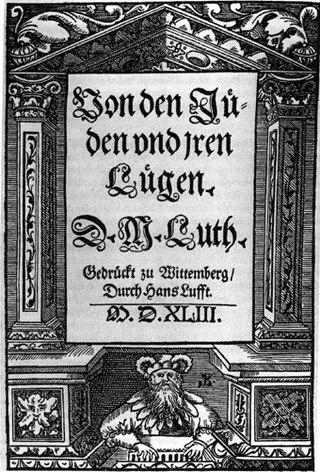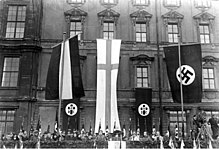Some Christian Churches, Christian groups, and ordinary Christians express religious antisemitism toward the Jewish people and the associated religion of Judaism.

Alfred Ernst Rosenberg was a Baltic German Nazi theorist and ideologue. Rosenberg was first introduced to Adolf Hitler by Dietrich Eckart and he held several important posts in the Nazi government. He was the head of the NSDAP Office of Foreign Affairs during the entire rule of Nazi Germany (1933–1945), and led Amt Rosenberg, an official Nazi body for cultural policy and surveillance, between 1934 and 1945. During World War II, Rosenberg was the head of the Reich Ministry for the Occupied Eastern Territories (1941–1945). After the war, he was convicted of crimes against peace; planning, initiating and waging wars of aggression; war crimes; and crimes against humanity at the Nuremberg trials in 1946. He was sentenced to death by hanging and executed on 16 October 1946.
The Confessing Church was a movement within German Protestantism during Nazi Germany that arose in opposition to government-sponsored efforts to unify all Protestant churches into a single pro-Nazi German Evangelical Church.
Religious antisemitism is aversion to or discrimination against Jews as a whole, based on religious doctrines of supersession that expect or demand the disappearance of Judaism and the conversion of Jews, and portray their political enemies in Jewish terms. This form of antisemitism has frequently served as the basis for false claims and religious antisemitic tropes against Judaism. Sometimes, it is called theological antisemitism.

Erich Koch was a Gauleiter of the Nazi Party (NSDAP) in East Prussia from 1 October 1928 until 1945. Between 1941 and 1945 he was Chief of Civil Administration of Bezirk Bialystok. During this period, he was also the Reichskommissar in Reichskommissariat Ukraine from September 1941 until August 1944 and in Reichskommissariat Ostland from September 1944. After the Second World War, Koch stood trial in Poland and was convicted in 1959 of war crimes and sentenced to death. The sentence was later commuted to life in prison and Koch died of natural causes in his cell at the Barczewo prison on 12 November 1986.

Lucy Dawidowicz was an American historian and writer. She wrote books about modern Jewish history, in particular, about the Holocaust.

German Christians were a pressure group and a movement within the German Evangelical Church that existed between 1932 and 1945, aligned towards the antisemitic, racist and Führerprinzip ideological principles of Nazism with the goal to align German Protestantism as a whole towards those principles. Their advocacy of these principles led to a schism within 23 of the initially 28 regional church bodies (Landeskirchen) in Germany and the attendant foundation of the opposing Confessing Church in 1934. Theologians Karl Barth and Dietrich Bonhoeffer drafted the Barmen Declaration the same year opposing Nazi doctrines.

The Myth of the Twentieth Century is a 1930 book by Alfred Rosenberg, a Nazi theorist and official who was convicted of crimes against humanity and other crimes at the Nuremberg trials and executed in 1946. Rosenberg was one of the principal ideologues of the Nazi Party and editor of the Nazi paper Völkischer Beobachter. In 1941, history professor Peter Viereck wrote: "In molding Germany's 'psychology of frightfulness' Rosenberg wields an influence as powerful as that of the much publicized Goebbels and the much feared Himmler and his secret police."

On the Jews and Their Lies is a 65,000-word anti-Judaic and antisemitic treatise written in 1543 by the German Reformation leader Martin Luther (1483–1546).
Nazi Germany was an overwhelmingly Christian nation with similarly overwhelmingly self-identified Christian leadership. A census in May 1939, six years into the Nazi era and after the annexation of mostly Catholic Austria and mostly Catholic Czechoslovakia into Germany, indicates that 54% of the population considered itself Protestant, 41% considered itself Catholic, 3.5% self-identified as Gottgläubig, and 1.5% as "atheist". Protestants were over-represented in the Nazi Party's membership and electorate, and Catholics were under-represented.

Positive Christianity was a religious movement within Nazi Germany which promoted the belief that the racial purity of the German people should be maintained by mixing racialistic Nazi ideology with either fundamental or significant elements of Nicene Christianity. Adolf Hitler used the term in point 24 of the 1920 Nazi Party Platform, stating: "the Party as such represents the viewpoint of Positive Christianity without binding itself to any particular denomination". The Nazi movement had been hostile to Germany's established churches. The new Nazi idea of Positive Christianity allayed the fears of Germany's Christian majority by implying that the Nazi movement was not anti-Christian. That said, in 1937, Hans Kerrl, the Reich Minister for Church Affairs, explained that "Positive Christianity" was not "dependent upon the Apostle's Creed", nor was it dependent on "faith in Christ as the son of God", upon which Christianity relied, rather, it was represented by the Nazi Party: "The Führer is the herald of a new revelation", he said. Hitler's public presentation of Positive Christianity as a traditional Christian faith differed. Despite Hitler's insistence on a unified peace with the Christian churches, to accord with Nazi antisemitism, Positive Christianity advocates also sought to distance themselves from the Jewish origins of Christ and the Christian Bible. Based on such elements, most of Positive Christianity separated itself from traditional Nicene Christianity and as a result, it is in general considered apostate by all mainstream Trinitarian Christian churches, regardless of whether they are Catholic, Eastern Orthodox, or Protestant.
The religious beliefs of Adolf Hitler, dictator of Nazi Germany from 1933 to 1945, have been a matter of debate. His opinions regarding religious matters changed considerably over time. During the beginning of his political life, Hitler publicly expressed favorable opinions towards Christianity. Most historians describe his later posture as adversarial to organized Christianity and established Christian denominations. He also criticized atheism.

Racial antisemitism is prejudice against Jews based on a belief or assertion that Jews constitute a distinct race that has inherent traits or characteristics that appear in some way abhorrent or inherently inferior or otherwise different from the traits or characteristics of the rest of a society. The abhorrence may find expression in the form of discrimination, stereotypes or caricatures. Racial antisemitism may present Jews, as a group, as a threat in some way to the values or safety of a society. Racial antisemitism can seem deeper-rooted than religious antisemitism, because for religious antisemites conversion of Jews remains an option and once converted the "Jew" is gone. In the context of racial antisemitism Jews cannot get rid of their Jewishness.

"Hitler's Table Talk" is the title given to a series of World War II monologues delivered by Adolf Hitler, which were transcribed from 1941 to 1944. Hitler's remarks were recorded by Heinrich Heim, Henry Picker and Martin Bormann and later published by different editors under different titles in four languages.

Vom Schem Hamphoras, full title: Vom Schem Hamphoras und vom Geschlecht Christi, was a book written by German Reformation leader Martin Luther in 1543, in which he equated Jews with the Devil and described them in vile language.
Kirchenkampf is a German term which pertains to the situation of the Christian churches in Germany during the Nazi period (1933–1945). Sometimes used ambiguously, the term may refer to one or more of the following different "church struggles":
- The internal dispute within German Protestantism between the German Christians and the Confessing Church over control of the Protestant churches;
- The tensions between the Nazi regime and the Protestant church bodies; and
- The tensions between the Nazi regime and the Roman Catholic Church.
Martin Luther (1483–1546) was a German professor of theology, priest and seminal leader of the Reformation. His positions on Judaism continue to be controversial. These changed dramatically from his early career, where he showed concern for the plight of European Jews, to his later years, when embittered by his failure to convert them to Christianity, he became outspokenly antisemitic in his statements and writings.
Historians, political scientists and philosophers have studied Nazism with a specific focus on its religious and pseudo-religious aspects. It has been debated whether Nazism would constitute a political religion, and there has also been research on the millenarian, messianic, and occult or esoteric aspects of Nazism.

Popes Pius XI (1922–1939) and Pius XII (1939–1958) led the Catholic Church during the rise and fall of Nazi Germany. Around a third of Germans were Catholic in the 1930s, most of them lived in Southern Germany; Protestants dominated the north. The Catholic Church in Germany opposed the Nazi Party, and in the 1933 elections, the proportion of Catholics who voted for the Nazi Party was lower than the national average. Nevertheless, the Catholic-aligned Centre Party voted for the Enabling Act of 1933, which gave Adolf Hitler additional domestic powers to suppress political opponents as Chancellor of Germany. President Paul Von Hindenburg continued to serve as Commander and Chief and he also continued to be responsible for the negotiation of international treaties until his death on 2 August 1934.

Richard Steigmann-Gall is an Associate Professor of History at Kent State University, and the former Director of the Jewish Studies Program from 2004 to 2010.















